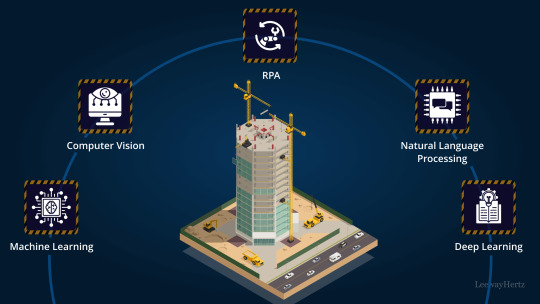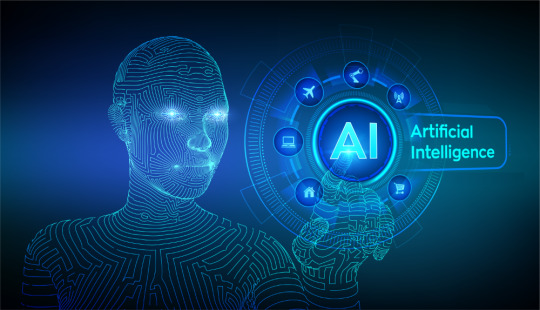The advent of ChatGPT has brought about a revolution in various industries. In the realm of Information Technology, ChatGPT's capabilities have been showcased in this insightful article on ChatGPT for Information Technology. Similarly, the automotive sector has witnessed a transformative journey with ChatGPT, as highlighted in this piece on ChatGPT for Automotive. Furthermore, ChatGPT's multifaceted impact on the media industry is explored in-depth in this article on ChatGPT for Media. For those in manufacturing, there's a tailored ChatGPT app that caters to specific business needs, as discussed in this post on ChatGPT for Manufacturing.
Don't wanna be here? Send us removal request.
Text
Leveraging the Power of AI in Legal Businesses: Exploring Benefits and Use Cases
In the fast-paced digital landscape of the 21st century, the integration of artificial intelligence (AI) into various industries has become increasingly prevalent, and the legal sector is no exception. AI technologies are revolutionizing the way legal businesses operate, providing them with unprecedented opportunities for efficiency, accuracy, and innovation. From automating routine tasks to enhancing decision-making processes, the benefits of AI in legal businesses are manifold.

Benefits of AI in Legal Businesses:
Enhanced Efficiency: One of the primary benefits of AI in legal businesses is its ability to streamline workflows and increase operational efficiency. AI-powered software can automate repetitive tasks such as document review, contract analysis, and due diligence, allowing legal professionals to focus their time and energy on more strategic and value-added activities. By automating these routine processes, AI not only accelerates the pace of work but also reduces the likelihood of errors, leading to significant time and cost savings for legal firms.
Improved Accuracy: AI technologies excel in processing vast amounts of data and extracting relevant insights with a high degree of accuracy. In the legal domain, AI-powered analytics tools can sift through extensive case law, statutes, and regulations to identify precedents, relevant rulings, and legal trends. By leveraging machine learning algorithms, these tools can also predict case outcomes and assess the likelihood of success in litigation, enabling lawyers to make more informed decisions and provide better counsel to their clients.
Cost Savings: Adopting AI solutions can result in substantial cost savings for legal businesses by reducing the need for manual labor and minimizing the risk of errors and inefficiencies. By automating tasks such as document drafting, legal research, and e-discovery, AI can significantly reduce the time and resources required to complete various legal processes, thereby lowering overhead costs and improving overall profitability. Additionally, AI-powered analytics can help identify areas of potential risk or non-compliance, allowing firms to proactively mitigate legal liabilities and avoid costly litigation.
Enhanced Client Service: AI technologies can enhance the quality of client service by providing faster response times, personalized legal advice, and proactive risk management. Virtual legal assistants powered by natural language processing (NLP) can interact with clients, answer common legal queries, and assist with document preparation, improving accessibility and convenience for clients. Furthermore, AI-driven analytics tools can track key performance metrics, monitor case progress, and identify opportunities for optimization, enabling legal firms to deliver superior outcomes and exceed client expectations.
AI Applications in Legal Businesses:
Document Review and Contract Analysis: AI-powered software can analyze large volumes of legal documents, contracts, and agreements to identify relevant clauses, inconsistencies, and potential risks. By automating the document review process, legal firms can expedite due diligence, ensure compliance with regulatory requirements, and mitigate the risk of contractual disputes.
Predictive Analytics for Case Outcomes: AI algorithms can analyze historical case data, judicial decisions, and legal precedents to predict the likely outcome of litigation or arbitration proceedings. By leveraging predictive analytics, lawyers can assess the strengths and weaknesses of their cases, develop effective litigation strategies, and advise clients on the most favorable course of action.
Legal Research and Data Mining: AI-powered search engines and knowledge management systems can retrieve and analyze vast repositories of legal information, including case law, statutes, and regulatory guidelines. By automating legal research and data mining tasks, these tools enable lawyers to access relevant legal insights quickly, identify persuasive authorities, and stay abreast of developments in the law.
Compliance Monitoring and Risk Management: AI technologies can help legal businesses monitor regulatory changes, assess compliance risks, and implement proactive risk management strategies. By analyzing regulatory frameworks and industry standards, AI-powered compliance tools can identify potential areas of non-compliance, recommend corrective actions, and facilitate ongoing compliance monitoring.
In conclusion, the integration of AI into legal businesses offers numerous benefits, including enhanced efficiency, improved accuracy, cost savings, and enhanced client service. By leveraging AI technologies for document review, predictive analytics, legal research, and compliance monitoring, legal firms can gain a competitive edge, optimize their operations, and deliver superior outcomes for their clients. As AI continues to evolve and mature, its transformative impact on the legal industry is expected to grow, paving the way for a future where technology and human expertise work in tandem to deliver justice and uphold the rule of law.
0 notes
Text
Unlocking Efficiency and Precision: The Transformative Role of AI in Construction
In an era defined by technological advancements, the integration of Artificial Intelligence (AI) into various industries has become more than just a trend; it's a necessity. Among these sectors, the construction industry stands out as a domain ripe for AI's transformative capabilities. From streamlining project management to enhancing safety protocols, the applications of AI in construction are diverse and far-reaching. Let's delve into the realm of AI in construction and explore how this disruptive technology is revolutionizing the way we build.

Understanding AI Applications in Construction
1. Project Planning and Management
AI algorithms excel at processing vast amounts of data and deriving insights from them. In construction, this translates to more efficient project planning and management. AI systems can analyze historical project data, identify patterns, and predict potential bottlenecks. By leveraging these insights, project managers can make data-driven decisions, allocate resources effectively, and optimize project timelines.
2. Design Optimization
In building construction, AI plays a crucial role in design optimization. Generative design algorithms can explore countless design options based on specified parameters such as materials, cost constraints, and structural requirements. This iterative process results in innovative designs that maximize functionality while minimizing material waste and construction time.
3. Safety Enhancement
Safety is paramount in construction, and AI technology offers innovative solutions to enhance workplace safety. AI-powered sensors and drones can monitor construction sites in real-time, detecting potential hazards and alerting workers to take preventive measures. Additionally, wearable devices equipped with AI can track workers' movements and vital signs, ensuring prompt assistance in case of accidents or health emergencies.
AI in the Construction Industry: Real-world Applications
1. Predictive Maintenance
AI-enabled predictive maintenance systems are revolutionizing equipment management in construction. By analyzing equipment performance data in real-time, these systems can forecast potential failures before they occur, enabling proactive maintenance and minimizing downtime. This predictive approach not only saves costs associated with unplanned repairs but also extends the lifespan of construction equipment.
2. Quality Control
Ensuring quality control throughout the construction process is critical for project success. AI-powered computer vision technology can inspect materials and structural components with unprecedented accuracy. By identifying defects or deviations from specifications early on, AI systems help maintain high construction standards and mitigate the risk of costly rework.
3. Energy Efficiency
With sustainability becoming increasingly important in construction, AI offers innovative solutions to improve energy efficiency in buildings. AI algorithms can analyze building performance data to optimize HVAC systems, lighting, and insulation, reducing energy consumption without compromising comfort or functionality. These AI-driven energy management systems not only contribute to environmental conservation but also result in long-term cost savings for building owners.
The Future of AI Technology in Construction Sector
The integration of AI into the construction industry is still in its infancy, but the potential for growth and innovation is immense. As AI algorithms become more sophisticated and data collection methods advance, we can expect to see even greater advancements in construction processes and outcomes. From autonomous construction vehicles to robotic bricklayers, the possibilities are endless.
Challenges and Considerations
While the benefits of AI in construction are undeniable, there are challenges that need to be addressed. Data privacy and security concerns, regulatory hurdles, and workforce readiness are among the key considerations for widespread adoption of AI technology in construction. Moreover, ensuring equitable access to AI-driven solutions is essential to prevent exacerbating existing disparities within the industry.
Conclusion
The integration of AI technology into the construction industry is reshaping the way we conceive, design, and build structures. From enhancing project efficiency and safety to optimizing resource utilization and sustainability, the applications of AI in construction are vast and multifaceted. As we continue to embrace AI-driven innovation, collaboration between industry stakeholders, policymakers, and technology developers will be crucial to harnessing the full potential of AI in construction and creating a more resilient and sustainable built environment for future generations.
Reference -
https://www.leewayhertz.com/ai-in-architecture
0 notes
Text
Unlocking Efficiency: AI in Demand Forecasting
In today's dynamic marketplace, accurate demand forecasting is crucial for businesses to optimize their operations, manage inventory efficiently, and meet customer demands effectively. With the advent of Artificial Intelligence (AI) technologies, demand forecasting has undergone a significant transformation, empowering organizations to predict future demand with unprecedented accuracy and agility.

The Role of AI in Demand Forecasting
AI has revolutionized demand forecasting by leveraging advanced algorithms and machine learning techniques to analyze vast amounts of historical data, identify patterns, and generate actionable insights. Unlike traditional forecasting methods that rely heavily on historical sales data and manual analysis, AI-driven demand forecasting models incorporate diverse data sources, including social media trends, economic indicators, and even weather patterns, to capture a more comprehensive view of market dynamics.
Methods of Demand Forecasting
Demand Forecasting in Supply Chain
In the context of supply chain management, accurate demand forecasting is essential for minimizing inventory costs, reducing stockouts, and improving overall supply chain efficiency. AI-driven demand forecasting enables businesses to optimize inventory levels, streamline procurement processes, and enhance supply chain resilience by anticipating demand fluctuations and proactively adjusting inventory levels and production schedules.
Demand Forecasting in Retail
In the retail industry, where consumer preferences and market trends evolve rapidly, demand forecasting plays a critical role in driving revenue growth and maintaining customer satisfaction. AI-powered demand forecasting solutions enable retailers to analyze vast amounts of data, including sales transactions, customer demographics, and online browsing behavior, to predict demand at the individual product level accurately. By leveraging these insights, retailers can optimize pricing strategies, allocate resources effectively, and personalize marketing campaigns to meet the diverse needs of their customers.
Conclusion
AI-driven demand forecasting has emerged as a game-changer for businesses across industries, offering unparalleled accuracy, scalability, and agility in predicting future demand. By harnessing the power of AI technologies, organizations can gain a competitive edge in today's fast-paced market environment, optimize their supply chain operations, and deliver exceptional customer experiences. As AI continues to advance, the future of demand forecasting holds immense promise for driving innovation, efficiency, and profitability in businesses worldwide.
References:
https://www.leewayhertz.com/ai-in-inventory-management/
https://www.leewayhertz.com/ai-in-production-planning/
0 notes
Text
AI in Customer Success: Revolutionizing Support through Automation
Introduction
In the rapidly evolving landscape of customer success, businesses are increasingly turning to Artificial Intelligence (AI) to enhance their customer support strategies. The integration of AI in customer success automation is transforming the way companies engage with their customers, streamlining processes, and ultimately improving overall satisfaction. This article explores the significant role of AI, including machine learning, in revolutionizing customer success.

The Rise of AI in Customer Success
1. AI for Customer Success
AI has become a game-changer in customer success by providing advanced tools to understand customer behavior, predict needs, and personalize interactions. Through AI-driven analytics, businesses can gain valuable insights into customer preferences, allowing for more targeted and effective support.
2. AI in Customer Success Automation
Automation is a key component of AI in customer success. Routine tasks such as ticket routing, data entry, and basic issue resolution can be automated, freeing up human agents to focus on more complex and high-value customer interactions. This not only improves efficiency but also allows businesses to deliver quicker and more accurate responses.
Artificial Intelligence in Customer Success: Enhancing User Experience
1. Personalization through AI
AI enables personalized customer experiences by analyzing vast amounts of data to understand individual preferences. This allows businesses to tailor their interactions, recommend relevant products or services, and address specific needs. The result is a more engaging and satisfying customer journey.
2. Proactive Issue Resolution
One of the significant benefits of AI in customer success is its ability to predict and proactively address potential issues. Machine learning algorithms can identify patterns in customer behavior that may indicate upcoming challenges, allowing companies to intervene before problems escalate. This proactive approach enhances customer satisfaction and loyalty.
The Impact of AI and Machine Learning in Customer Success
1. Data-Driven Decision Making
AI and machine learning empower businesses to make informed decisions based on real-time data. By analyzing customer interactions, feedback, and historical data, companies can identify trends and areas for improvement. This data-driven approach enables continuous optimization of customer success strategies.
2. Efficient Resource Allocation
With AI handling routine tasks, human agents can focus on complex problem-solving and building meaningful relationships with customers. This efficient resource allocation ensures that human expertise is utilized where it matters most, contributing to a more effective and customer-centric support system.
Challenges and Future Outlook
While AI in customer success offers tremendous benefits, there are challenges such as data privacy concerns and the need for ongoing training to keep up with evolving technology. However, as AI continues to advance, these challenges are expected to be addressed, opening up even more possibilities for the future.
In conclusion, the integration of AI in customer success is reshaping the way businesses interact with their customers. From automation to personalization, AI is enhancing the overall support experience, leading to improved customer satisfaction and loyalty. As technology continues to evolve, businesses that embrace AI and machine learning in customer success will undoubtedly stay ahead in the competitive landscape.
Reference: https://www.leewayhertz.com/ai-in-complaint-management/
0 notes
Text
Unveiling the Power of AI for Customer Sentiment Analysis
Introduction
In the rapidly evolving landscape of business, understanding customer sentiment is paramount for success. The rise of Artificial Intelligence (AI) has revolutionized various aspects of business operations, and one of the most significant applications is in sentiment analysis. This article explores how AI is harnessed for customer sentiment analysis, the advancements in AI-based sentiment analysis, and the pivotal role played by AI development services in this domain.

The Significance of Customer Sentiment Analysis
Customer sentiment analysis involves gauging the feelings, opinions, and attitudes of customers towards a product, service, or brand. Traditionally, businesses relied on surveys, feedback forms, and reviews to gather this information. However, with the advent of AI, the process has become more efficient, accurate, and timely.
Understanding customer sentiment is crucial for businesses aiming to enhance customer satisfaction, improve products or services, and make informed decisions. AI facilitates the automatic analysis of vast amounts of textual data, enabling businesses to gain insights into customer sentiments on a real-time basis.
AI-Based Sentiment Analysis: An Overview
1. Natural Language Processing (NLP)
AI utilizes Natural Language Processing (NLP) algorithms to decipher and understand human language. NLP enables machines to comprehend the nuances of language, including context, tone, and sentiment. Through sentiment analysis AI models can classify text data into categories like positive, negative, or neutral, providing a comprehensive overview of customer opinions.
2. Machine Learning Models
Machine Learning (ML) plays a pivotal role in training sentiment analysis models. These models learn from historical data, becoming adept at recognizing patterns and sentiments. As more data is fed into the system, the accuracy of predictions improves. ML-based sentiment analysis adapts to evolving language trends and is capable of handling diverse datasets.
3. Deep Learning
Deep Learning, a subset of ML, involves neural networks with multiple layers to simulate human decision-making. In sentiment analysis, deep learning models can capture intricate relationships within data, enhancing the accuracy of sentiment classification. This allows for a more nuanced understanding of customer sentiments, going beyond simple positive or negative categorizations.
AI Development Services in Sentiment Analysis
1. Customized Solutions
AI development services offer businesses tailored solutions for sentiment analysis based on their unique requirements. These services involve developing AI models specific to the industry, brand, or product, ensuring accurate and relevant results. Customization allows businesses to focus on the aspects of sentiment that matter most to their operations.
2. Integration with Existing Systems
AI development services seamlessly integrate sentiment analysis capabilities into existing business systems. This integration facilitates a smooth transition to AI-powered sentiment analysis, minimizing disruptions to daily operations. Businesses can leverage their existing data repositories to enhance the efficiency and accuracy of sentiment analysis.
3. Continuous Improvement
AI development services not only build AI models but also ensure continuous improvement. Regular updates and adaptations are essential to keep sentiment analysis models relevant in a dynamic market. AI developers refine algorithms based on feedback and emerging trends, guaranteeing that businesses stay at the forefront of sentiment analysis capabilities.
Conclusion
The utilization of AI for customer sentiment analysis has transformed the way businesses interpret and respond to customer feedback. From NLP and machine learning to deep learning, AI brings a range of sophisticated tools to decipher the intricate language of customer sentiments. AI development services further empower businesses by providing customized solutions, seamless integrations, and continuous improvement.
As businesses strive to stay competitive in an ever-evolving market, harnessing the power of AI for sentiment analysis is not just a choice but a necessity. The insights derived from AI-driven sentiment analysis empower businesses to make data-driven decisions, enhance customer satisfaction, and ultimately thrive in the dynamic landscape of modern commerce.
1 note
·
View note
Text
Generative AI in Retail and E-Commerce: Transforming the Shopping Experience
In the ever-evolving landscape of retail and e-commerce, technological advancements continue to redefine the way businesses operate and engage with consumers. One such groundbreaking innovation is Generative AI, a branch of artificial intelligence that holds the potential to revolutionize the shopping experience. From personalized recommendations to enhanced product design, Generative AI is leaving its imprint on the retail sector, offering a glimpse into the future of consumer interactions.

Understanding Generative AI in Retail
Generative AI involves the use of algorithms to generate new and unique content. In the context of retail, this means creating product recommendations, designs, and even marketing content tailored to individual customer preferences. By analyzing vast amounts of data, including past purchases, browsing behavior, and demographic information, Generative AI can predict what products a customer is likely to be interested in, providing a more personalized shopping experience.
Personalized Recommendations
One of the primary applications of Generative AI in retail is the creation of personalized recommendations. Traditional recommendation engines often rely on collaborative filtering or content-based methods, but Generative AI takes it a step further. It can analyze complex patterns and relationships in customer data to suggest products that align not only with past preferences but also with evolving tastes and trends.
Generative AI in E-Commerce: Redefining Customer Interaction
In the realm of e-commerce, where online retailers compete for consumers' attention, Generative AI plays a crucial role in optimizing the digital shopping journey.
Virtual Try-Ons and Augmented Reality
Generative AI is powering virtual try-ons and augmented reality experiences, allowing customers to visualize how products will look on them before making a purchase. This not only enhances the overall customer experience but also reduces the likelihood of returns, as shoppers can make more informed decisions about the fit and style of the items they're considering.
Dynamic Pricing Strategies
Retailers are leveraging Generative AI to implement dynamic pricing strategies. By analyzing market trends, competitor pricing, and customer behavior, these systems can adjust prices in real-time, optimizing for maximum revenue and competitiveness. This dynamic approach ensures that prices remain competitive and attractive, providing a win-win situation for both retailers and customers.
Enhancing Product Design and Innovation
Generative AI is not limited to the front-end customer experience; it is also making waves in the back-end processes, particularly in product design and innovation.
Automated Design Generation
Retailers are using Generative AI to automate the product design process. By inputting specific parameters and constraints, these algorithms can generate countless design variations, helping designers explore new ideas and iterate rapidly. This not only accelerates the design phase but also fosters creativity by presenting novel concepts that human designers might not have considered.
Market Trend Analysis
Staying ahead of market trends is crucial in the fast-paced world of retail. Generative AI analyzes vast amounts of data from social media, customer reviews, and industry publications to identify emerging trends. This information is invaluable for retailers seeking to align their product offerings with the current preferences and expectations of their target audience.
Challenges and Considerations
While the integration of Generative AI in retail and e-commerce holds immense promise, it comes with its set of challenges. Data privacy concerns, ethical considerations, and the need for transparent algorithms are critical factors that businesses must address. Striking a balance between customization and privacy is paramount to ensure that customers feel comfortable sharing their data in exchange for a more personalized shopping experience.
Conclusion: A New Era of Retail
Generative AI is ushering in a new era of retail and e-commerce, where the shopping experience is not only highly personalized but also technologically advanced. From recommendation engines that understand individual preferences to augmented reality experiences that bring products to life, the impact of Generative AI is multifaceted. As businesses continue to embrace and refine these technologies, consumers can anticipate a future where every aspect of the shopping journey is tailored to their unique tastes and preferences. The synergy between artificial intelligence and retail is not just transforming the industry; it's redefining the very nature of how we shop and engage with brands in the digital age.
0 notes
Text
Unlocking Efficiency and Innovation: Generative AI in Supply Chain Management
In the ever-evolving landscape of supply chain management, businesses are constantly seeking innovative solutions to enhance efficiency, reduce costs, and streamline operations. One of the groundbreaking technologies making waves in this arena is Generative AI, a powerful tool that holds the potential to revolutionize the way supply chains operate. In this article, we will delve into the concept of Generative AI in the context of supply chain management, exploring its applications, benefits, and the transformative impact it can have on the industry.

Understanding Generative AI for Supply Chain
Generative AI refers to a class of artificial intelligence that focuses on creating new content, whether it be images, text, or even entire processes. In the realm of supply chain management, Generative AI is leveraged to optimize and automate various aspects of the supply chain, from demand forecasting to logistics planning.
Applications of Generative AI in Supply Chain
Benefits of Generative AI in Supply Chain Management
Challenges and Considerations
While Generative AI holds immense potential, its implementation in supply chain management is not without challenges. Security concerns, data privacy, and the need for skilled personnel to manage and interpret the generated insights are some of the key considerations that businesses must address.
Future Outlook
The integration of Generative AI in supply chain management is an ongoing process, and as technology continues to advance, we can expect even more sophisticated applications. Machine learning models within Generative AI are likely to become more adept at handling complex and dynamic supply chain scenarios, further optimizing operations and contributing to the resilience of global supply chains.
Conclusion
Generative AI is not just a technological marvel; it's a game-changer for the supply chain industry. As businesses grapple with the complexities of global markets, customer demands, and unforeseen disruptions, Generative AI emerges as a beacon of innovation and efficiency. From forecasting demand with unprecedented accuracy to optimizing the entire logistics chain, the applications of Generative AI are reshaping the way businesses approach supply chain management. As we navigate the future, embracing the transformative power of Generative AI is not just a choice but a strategic imperative for businesses looking to stay ahead in the dynamic world of supply chain management.
0 notes